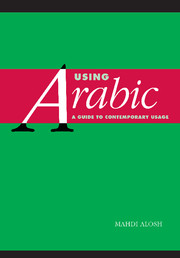1 - Varieties of Arabic
Published online by Cambridge University Press: 05 June 2012
Summary
What is Arabic?
The word ‘Arabic’ is an umbrella term that subsumes several varieties of this language, which vary with region and situation. Learners of Arabic and those who wish to learn Arabic should be aware of all aspects of the linguistic situation so that they can make appropriate choices with regard to which variety they need to study and whether a single variety would be adequate for their purposes. Those who have already achieved a certain level of proficiency can benefit from this information in filling the gaps in their linguistic-cultural knowledge of Arabic. In addition, attaining an advanced level may not be possible without the ability to perform appropriately, using more than one variety, i.e., Modern Standard Arabic and one of the other Arabic varieties.
This book is focused on Modern Standard Arabic and how to use it correctly and develop it further. The first chapter deals with Arabic as a complete whole, including the colloquial end of the language continuum. With this background, the student of Arabic will have a better understanding of the linguistic situation in its entirety and will be able to assess his competence in relation to what he knows about it.
Arabic diglossia
Arabic is one of a few language systems in the world that are characterized by the coexistence of two distinct varieties of the same language, used side by side in the same speech community, each having a set of specialized functions. Situational and contextual factors influence the choice of elements from either variety in a speech event.
- Type
- Chapter
- Information
- Using ArabicA Guide to Contemporary Usage, pp. 1 - 52Publisher: Cambridge University PressPrint publication year: 2005



